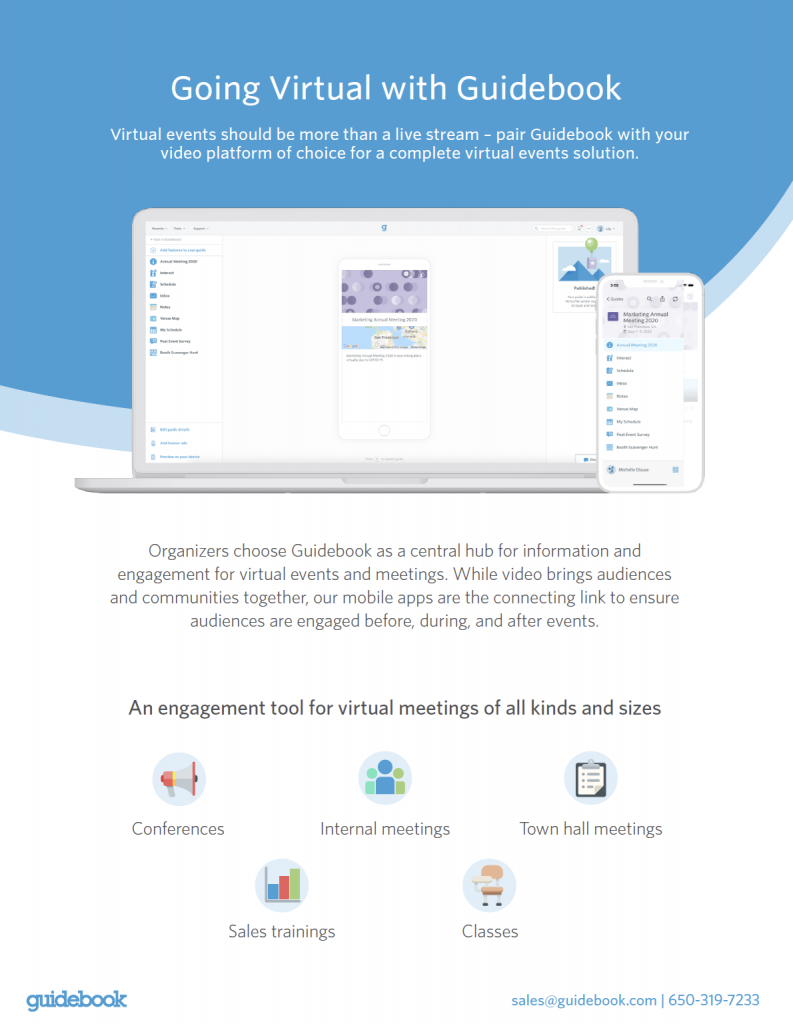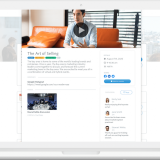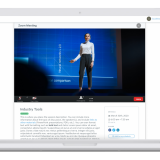Beyond Virtual: The Hybrid Events Landscape in 2020 and Beyond
What are hybrid events?
Hybrid events are events that have both virtual and physical, in-person components. Historically, a prime example of a hybrid event is just one that is an in-person event that’s been live streamed for an online audience at home.
While they’re nothing new, hybrid events have certainly become top-of-mind as COVID-19 has changed the way the world lives and conducts business. Not only that, but hybrid events continue to evolve and close the gap between the experiences that physical and virtual audiences have. We’re seeing today’s hybrid events go beyond a live stream to fully engage both virtual and in-person audiences through chat, streaming, networking, and more.
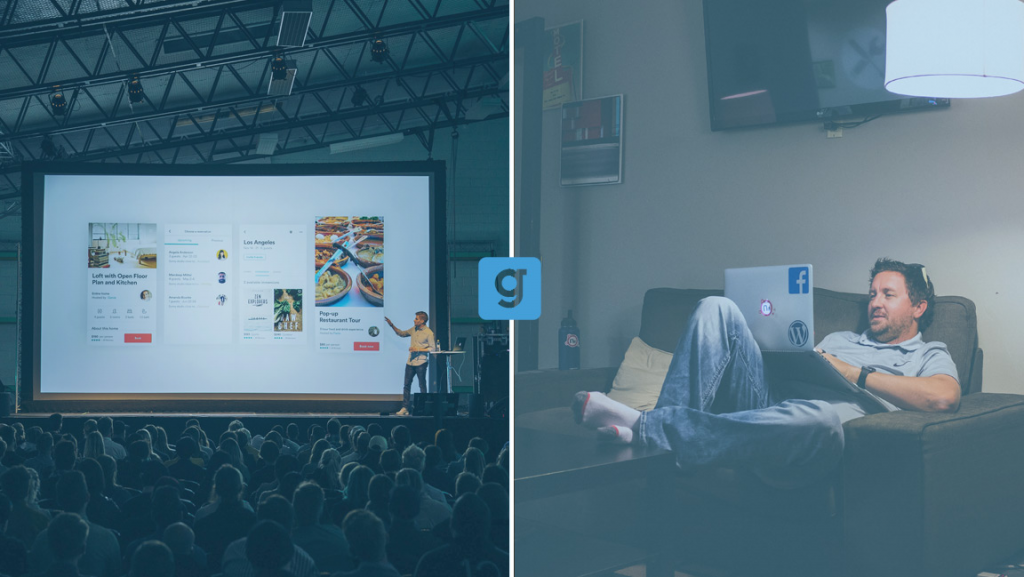
Real quick: remember when event apps weren’t a thing at all?
Ten years ago, event planners thought of an “event” as just the literal event that happens on that day. But as technical talent, like the Guidebook Founders, came onto the scene and started reimagining how mobile apps could reinvent the entire event experience, people quickly caught on and started to reinvent their event lifecycle — before, during, and after their events. From the weeks of advertising, list building, messaging, ticket sales, and everything else needed to bring the event to life to the days immediately before the event where attendees planned their sessions, read materials, prepared, etc. and to the days following the event, all of this was reimagined as people began to elevate their event experience.
Before the introduction of the mobile event app, all of this was super difficult. Event planners had email and forums to spread their message, but apps changed the game and reinvented the events industry, with mobile event apps becoming a pivotal component of events as a whole.
The Rise of Virtual and Hybrid events in the wake of COVID-19
Virtual vs Hybrid Events
Let’s address how hybrid events differ from virtual ones. Virtual events are ones where 100% of event attendees attend online. In recent months, you probably have attended several. These could be webinars being hosted on Zoom, live streams of DJs sharing music with fans on Twitch, or a recording of a big enterprise keynote speech. Each virtual event has varying degrees of engagement, too. Attendees may be encouraged to chat in their questions, keep their webcams on and ask questions, or neither of the above.

Hybrid events, however, combine this virtual, online component with a physical, in-person audience. They don’t limit event organizers to one or the other, and as a result, attendance is maximized by encompassing a broader audience and allowing room for far more flexibility.
COVID-19 is the undisputed catalyst for the recent boom in both virtual and hybrid events, but by no means is either a new form of event.
What did Hybrid Events look like before COVID-19?
For years, large-scale events with tens or hundreds of thousands of attendees often tacked live streaming onto an existing physical event to reach millions more people than they normally would. In 2019, for example, E3 had 66,100 physical attendees. But by leveraging video and live streaming, their team was able to reach a global audience online, sharing press releases and exciting updates to anyone tuning it from home.

Another example is Coachella Valley Music and Arts Festival. Understanding that with limited tickets available and many millions more who wanted to attend, the Coachella team decided to invest heavily in live streaming for both weekends of their event on their Youtube channel. For ticket holders attending the live event, it’s business as usual. But for folks who couldn’t make it that weekend (or that year at all) and still wanted to share the hype, this move toward a hybrid event was game changing. A new term, Couchella, was born to signify the shared experience that virtual attendees could have at home on their couches. Today, the Coachella Youtube channel has 1.68M subscribers and is the go-to place to attend Coachella virtually.
You can see how live streaming and adding an online, video component to physical events has been such a game changer for large-scale events. But hybrid events don’t stop there — not anymore, at least. Today, event organizers are bridging the gap between physical and virtual attendees with new, innovative networking features. We’ll get into those a bit later on in the article.
How has COVID-19 been the catalyst for this increase in virtual and hybrid events?
The unexpected pandemic of 2020 took the world by storm, forcing event planners to scramble and make the most out of an unknown situation. With physical, in-person events no longer being an option, event planners were forced to shift to virtual events — forcing the entire industry to take three steps backwards and reevaluate how they were planning, organizing, and assessing the quality of their events before, during, and after.

But while virtual events offered organizers an agile solution, they came at a high price and forced planners to think beyond simple event logistics. With less focus on the operational details — such as room assignment, venue arrangement, etc. — planners were now tasked with making sure that their engagement levels were still on par with an in-person event, despite the shift in event format. And while this was an easy concept to grasp, actually executing an interactive and engaging virtual event proved to be difficult. Not only were organizers learning how to create engaging sessions for their audiences, but their audience was simultaneously learning how to interact with them in a more digital landscape.
The aftermath of the spread of COVID-19 led to a rapid transition from in-person, physical events to hybrid or virtual events, which seems to be par for the course for the foreseeable futures. Even when things return to the “new normal”, it is likely that event organizers will still be investing heavily in hybrid events.
Hybrid events in 2020 and beyond: Why should I run a hybrid event?

Wider audience reach
By removing the physical, financial, and logistical barriers that prevent people from attending a live, in-person event, you’re able to maximize the number of folks you can communicate with around the world, therefore increasing your audience reach and attendee numbers.
By not limiting your event to a single format, whether that’s virtual or in-person, you’re able to capitalize on the strengths of each. Expanding your audience reach is a win-win for you and your attendees. No matter how big or popular your event is, it is inevitable that there is an entire audience of potential attendees who simply do not care to go to events, who feel like they get sick when traveling, or people who don’t think it’s worth the amount of time and effort to invest a full day (or days). Hybrid events unlock this group of people who now have the option of attending your event virtually. Even better, you’ll also have that core group of fanatics who love going to your event in-person. And as it turns out, the overlap in these two groups is astonishingly low.
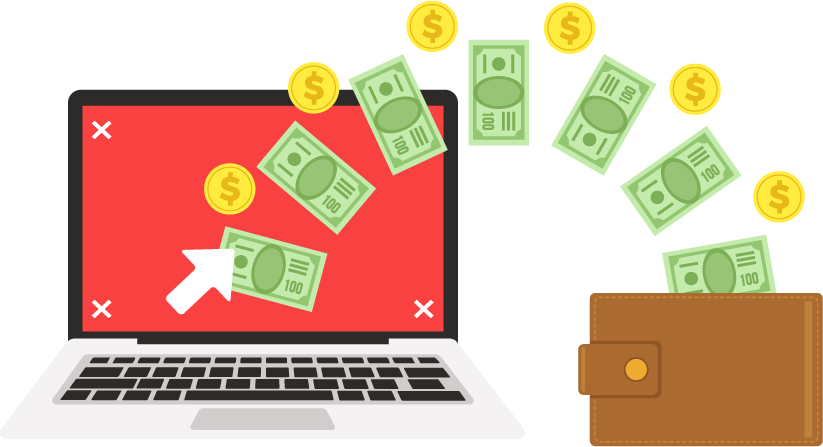
Higher Return-on-Investment
Why do sponsorship packages at huge events, like Coachella, cost infinitely more than those at a small event, like your daughter’s basketball tournament? While there isn’t one single reason, audience reach is the number one factor. If you’ve got hundreds of thousands of people attending an event (virtually or in-person), sponsors are willing to invest a lot more money because they’re getting in front of more faces. Being able to extend your event to a much larger audience means you’re able to boast more impressive sponsorship packages, or even advertise your virtual event with innovative advertising formats (like an audio advertisement as you’d hear on a podcast).
Event app sponsorship is an incredibly lucrative way of generating revenue for your event, albeit a bit confusing for beginners. If you’re interested in learning more about how to set up sponsorship packages for your event, and haven’t already read it, check out our post, “6 Elements You Need to Build a Winning Event Sponsorship Proposal”.
Hybrid event apps: How does mobile come into play?
The beauty of hybrid events, as we’ve touched on, is that an event organizer is able to reach people regardless of where they are, whether that’s in the comfort of their own homes or at an actual event. Today, the world may be static, but wherever anyone is, they’ll likely have their phone, making mobile a key part of event strategy. And to take it a step further, research shows that even when the world reaches the “new normal,” post-pandemic, hybrid and virtual events will continue to have a place in the market.
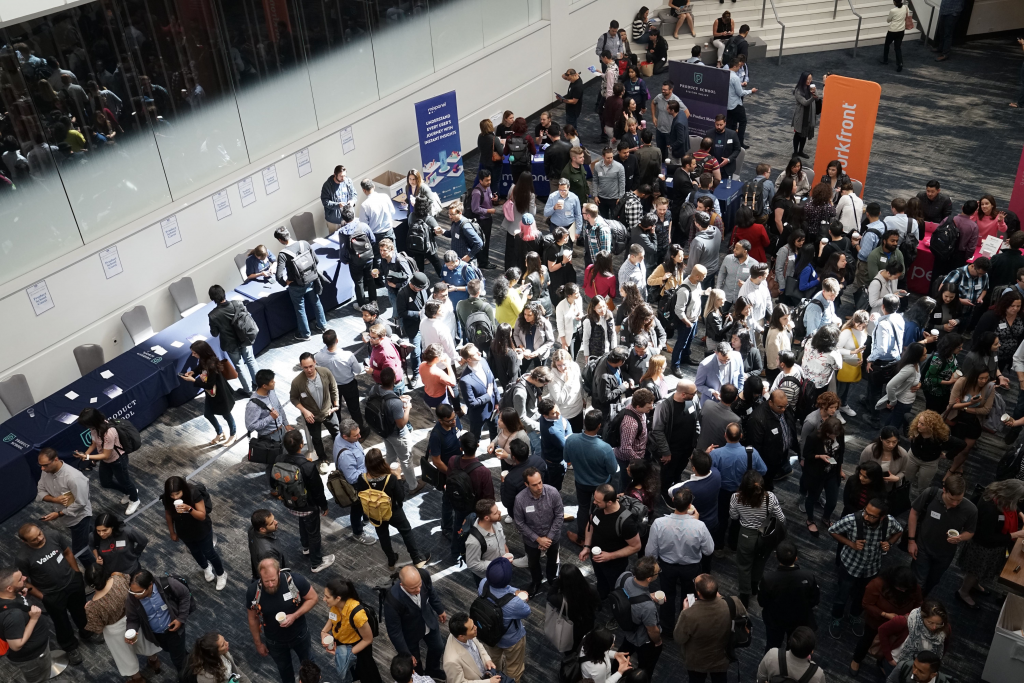
The importance of networking in events
People typically attend events to learn new things and to meet new people. But in this “new normal” where people are no longer able to meet in person, how are hybrid and virtual events able to get people to connect with each other?
There are countless solutions, some better than others. For example, Slack is a great communication tool, but it doesn’t enable networking for attendees who have never met and don’t know who other people are. So while they may be engaging with other people through conversations, there’s no clear way for them to network properly.
We’ve touched on how hybrid events allow event organizers to reach people in-person or virtually. But what about presenters and attendees themselves? Networking is such a core component of events, yet by simply live streaming a physical event, there’s no way for those two different audiences to really get in touch with one another. Technically that’s a hybrid event, but it’s sort of a half-hearted attempt at addressing the actual goals of the event.
If you run a hybrid event, what do you do?
People who attend physically are able to meet each other, touch elbows, and get to know each other. So the physical audience is mostly fine, albeit maybe a bit skittish about interacting with and meeting new people. Though with COVID-19 still looming for at least another year, are people really going to mingle with strangers, shake hands, grab drinks after the show, and engage in all the other common interactions we see at in-person events? The chances of this are pretty slim.

Additionally, you don’t want to miss out on the opportunity to engage with people who are not physically present. Let’s take me, for example. I’m a digital marketer whose interests lie strongly in Search Engine Marketing (SEM). If I’m at a big event, like Mozcon, and I see some SEO Managers in the attendee list who I’d like to meet, but they’re virtual attendees, how would I do that?
With a hybrid event app, I see them in the Attendee list beforehand, start a conversation, ask to meet (virtually), and we’re all set. Even better, with a feature like Guidebook’s Meeting Booking, I can set up a group chat of SEO Managers like me and invite them to meet up. This is an experience that I would’ve missed out on altogether without the help of an event app.
I’m also someone who doesn’t love walking around and having awkward, introductory conversations with strangers, so this is a great option for me — I’m able to make the most of my time and be comfortable doing it. Even if someone isn’t there in person, he or she isn’t missing out on the experience. Regardless of the format of your event, whether it is virtual, in person, or a hybrid of both, your event should offer networking capabilities that surpass physical limitations that may or may not exist for attendees.

Mobile offers you a flexible tool during times of confusion and uncertainty
Like some event planners out there, you may be a bit unsure about the event landscape, how the event industry will bounce back, and what this means for your role. It’s likely you’ve been told to go out and find technology and tools that help enable events to go virtual or hybrid, but what with no clear direction and no background knowledge on if those tools work or don’t work. There’s plenty of uncertainty going around. No one knows how well their companies will fare or if they’ll even survive the second wave of COVID.
The investment in any tool, both financially and in terms of human capital, has an inherent risk. But the flexibility that using a hybrid event app like Guidebook is providing you is huge and shouldn’t be discounted.
Think about this:
It doesn’t matter what happens to your event — if it happens to be forced virtual, we’ve got you. If things ease up and you’re able to go back to a physical event, we’ve got you. If things are somewhere in the middle and you decide to give a hybrid event a shot, we’ve got you! The beauty of Guidebook is that no matter what format your event has, we have a flexible solution that can help you.
Event planners need to provide people access to content, tools, networking, etc. That’s where the security and flexibility of our Cover Pages and a truly powerful event app platform come into play. And that’s exactly the reason why we’re continuing to build out newer, better networking tools every day. Just a few weeks ago, we launched Meeting Booking, an awesome new feature which gives attendees (physical or virtual) the ability to book meetings with one another, directly within the app.
The same team that created and brought mobile app technology to the events industry is now working on reinventing it for a new era, where attendees can maximize their experience whether they’re physically at an event or on their couch at home.
If you’d like to learn more about how virtual or hybrid event apps are easing the transitions that event planners are facing every day, get in touch with our team for a live demo of our app platform, Builder. With such uncertain times in the events industry, it’s important to be equipped with a tool that’s as flexible as you need to be.
